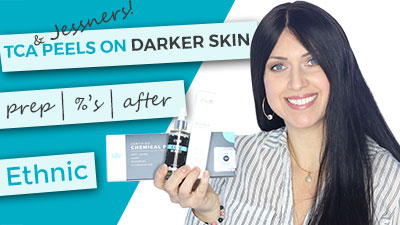
Transcript
Today I want to elaborate for a few minutes about TCA peels on those with medium to darker skin types.
If you have a more melanin-rich skin tone, and are wondering if TCA is for you, relax … yes it is. All skin types can safely use TCA with the proper skin conditioning.
What is a chemical peel?
Chemical peels have been used for centuries, but have become very prominent since the 1960’s. Studies and documentations over the decades have given us a deep understanding of the possible effects and potential outcomes of chemical peels on the skin. Some acids are milder – such as lactic, glycolic salicylic and mandelic and effect only the epidermis, while others – such as TCA - can penetrate deeper into the layers of skin for a more dramatic outcome.
When an acid is applied directly to the skin it creates a controlled burn or chemical wound. This wound creates a condition in the skin where the tissues need to regenerate themselves and this leads to an improved texture, clarity, reduction of markings, scars, wrinkles and acne. It also leads to increased thickness in the dermis.
You are here because you are wanting to try a TCA peel. So, first let’s figure out what your Fitzpatrick skin type is.
The Fitzpatrick Skin typing is a detailed classification that gives indications as to how a certain skin type will react to various treatment conditions.
Skin color, unaltered eye and hair color, ethnic origins, and response to UV light are all examined. Based on these findings, we end up with six different Fitzpatrick types that begin with very fair skin and graduate to very dark skin.
When we think of Caucasian, we think white. But white can come in a variety of shades and this will influence whether the client is a Fitzpatrick 1, 2 or even 3. For reference I am a 2.
Blue eyes
Tans after several burns. Freckles.
European and German.
The same thing is true with the darker skin types. What we have found is that no matter how much melanin is in the skin, if you fall into types 4, 5 or 6, you will need special skin conditioning when you are looking to perform chemical peels to help avoid complications.
To simplify this, if your heritage is Mediterranean, Asian, Latino, Indian, Native American, African or any range that is not very light, you will need to pretreat your skin.
Another quick condition to note is how dry or oily your skin naturally is. If you have drier skin, it will take up the acid more quickly than someone with oily skin. No matter what your skin type though, the preparation will be the same.
Preparation
Anyone looking to perform a TCA peel will need to prepare their skin. The main things you will do are:
- Use a Retinol every evening prior to bed. This will help to encourage rapid turnover of your skin. This will clear out your pores, gently thin the dead skin and it will put your skin into a hyper regenerative state – so you will flake and heal more quickly after your peel is applied.
- Use protection every day. This includes antioxidants such as vitamin C or copper along with actual Sun protection. You want to fade any tan you have before applying a chemical peel.
Now, since you have more melanin in your skin, you have the potential to get PIH or Post Inflammatory hyperpigmentation. This is the same thing as the Mark that is left behind after a pimple.
It is where the skin was inflamed and then the melanin dumped into the layers and caused a discoloration. Sure, it will go away at some point – but we like to try and avoid that if at all possible. So YOU will do just that and will start using a Melanin Inhibitor 2x per day prior to any other products to prepare your skin
*We also recommend this if you naturally have many freckles or are prone to hyperpigmentation or have melasma.
Our Fade Bright was created for just this use. The alpha arbutin in the formula will help to turn down the melanin production in your skin.
- This will help to fade any tan you currently have.
- It will help you to avoid PIH after your peel application.
So your morning will consist of washing your skin, patting your face a bit and then applying 1-2 pumps of Fade Bright to all areas you wish to even your skin tone –
- and that you are going to be applying a chemical peel to. Then follow with your Antioxidant and an SPF. With darker skin types generally a 30 is just fine.
Your evening regimen will consist of the same: Wash, Fade and then your Retinol Molecular Serum.
We recommend you prep your skin in this manner for at least 2 weeks. It is always preferable to prep for longer (such as 4 weeks) – but so many are in a rush to start the peeling process.
You know your skin though, and if you have several areas of pigmentation already, or have a very uneven skin tone, make sure to extend your prep until your skin is looking uniform and healthy prior to your peel.
Which percentage should you choose?
Now here is the big point I want to make. Even though your skin is well prepared, we want you to be cautious with the strength of TCA that you choose.
If you are going to be peeling your face – begin with the 13%. Start with only 1 or 2 layers and over the next several peels you can work your way up to more – IF you feel you need a deeper peel.
NEVER be in a hurry to get to the next percentage. You are ALWAYS safer with more layers of a lesser percentage. *Example. You applied 3 layers of TCA 13% and now you want to jump up to the 20%. DO NOT DO IT. If you have been applying 5 layers of the TCA 13% for several applications, and you are ready to move up to the 20%, then go ahead and begin again at only 1 layer.
If you are peeling your body, we always recommend the 20% TCA for melanin rich skin types. Leave the 30% for those with very light skin. Such a strong percentage has the possibility of inducing PIH and we want to avoid that if at all possible.
After your peel
Once you have applied your peel according to the directions and rinsed, apply your Fade Bright again. This will help – again, to reduce the likeliness that inflammation will cause PIH. Next will be our Luminosity Method .50% Retinol if you want extra fast flaking and then, apply a soothing, calming oil such as Emu oil or our Essentials Healing Blend.
A few hours to a few days after your peel you will most likely see some darkening of the skin. This is NOT PIH. What happens with skin types 4, 5, and 6 is that as the skin is drying and preparing to flake off it will naturally darken.
Here are a couple of pictures of what that looks like. Don’t panic, it will shed off in the following 5-10 days.
Future.
Now you have applied your first peel, the first question we get is “do I have to keep using the Fade Bright?”. The answer is yes. You are going to be performing a Peel Series. That is between 6-8 peels in a row.
We want your skin to stay in this melanin controlled condition. So keep applying your Fade Bright 2x per day right up to your peel and then again immediately after.
So there really isn’t too much more that you have to do with darker skin, but you want to be sure to follow the recommendation we have laid out before you. If you don’t follow them you may end up with pigmentation that will take several weeks to lessen or remove. Always error on the side of caution when you are performing peels.
Do you still have more questions?
We are here to help



